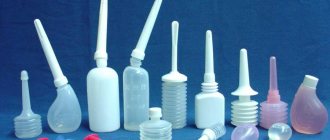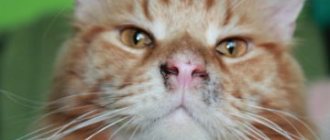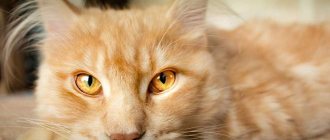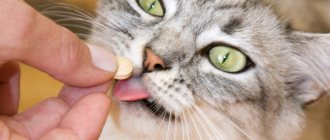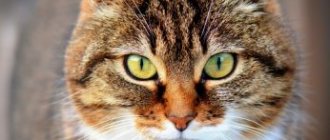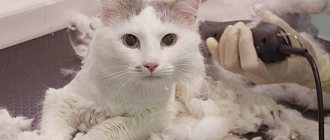Cleaning cats' ears is quite controversial among pet owners. Some consider this procedure optional, others carry it out almost every day.
In fact, most cats do not need frequent ear cleaning. It is enough to regularly examine them in order to detect the first signs of disease and wipe them with a special lotion once a month. However, when carrying out this procedure, certain rules must be followed so as not to harm the health of the pet.
Features of the structure of the animal's auricle
A cat’s ear, like a person’s, consists of 3 sections:
- External: a funnel-shaped auricle, covered on the inside with a small amount of guard hairs and on the outside with hair, and the external auditory canal.
- Middle: includes the eardrum and the bony tympanic cavity, where the 3 auditory ossicles are located. They play one of the leading roles in the perception of sound.
- Internal: hollow bone formation in the temporal bone, the most complex section. It contains the receptor channels of hearing and the vestibular apparatus.
Damage in children
Very often, parents wonder how to treat a child’s wound. If you have a baby in the house, then the first aid kit must be equipped with hydrogen peroxide, brilliant green, fucorcin or an alcohol solution of chlorophyllipt. The tactics for dealing with cuts in children should be the same as for injuries to the skin of adults.
The difficulty is that children often do not give the opportunity to treat the wound. But this is not the case when you need to feel sorry for the baby. Parents should do everything possible to wash the damaged area and treat it properly. At this time, there is no point in scolding the baby, you need to calm him down and try to explain what exactly you are doing with his wound.
Does a cat need ear cleaning?
Indoor cats do not need regular ear cleanings like dogs. And ear diseases are relatively less common among them than other animal species.
Under normal conditions, sulfur is secreted in small quantities. If you frequently clean your cat's ears, the secretion begins to be produced more strongly. And this leads to ear plugs and other problems. To maintain a healthy ear, it is enough to periodically clean the inside of the auricle and the beginning of the ear canal.
Exceptions are cats with a small amount of fur (hairless). In such animals, contamination occurs more quickly, so they need regular cleaning. The sparse hairs inside the ear cannot provide protection from dust and dirt, and the body compensates for this by increasing the production of wax.
This feature is typical for the following breeds:
- kohana;
- elf;
- sphinx;
- Peterbald;
- lefty
Rex, Maine Coon, Savannah, Somali, Oriental and Abyssinian cats have large ears, in which dust also quickly accumulates. It is recommended to clean it about once a week. However, due to individual characteristics, some representatives of these breeds may have ears that remain clean for a long time.
Excessive accumulation of sulfur leads to the proliferation of bacteria and fungi. The cat's immunity weakens, it loses the ability to resist parasitic diseases, and is often affected by ear mites.
Fold-eared cats cannot wash their ears on their own due to the structure of the auricle. Therefore, the owner must process them approximately once every 2 weeks. It is also not advisable to clean the ears of fold-eared cats excessively often. After all, without natural secretion, they are more likely to develop various diseases.
If your pet has too much wax and dirt in his ears, and they accumulate quickly after cleaning, you should take the animal to the veterinarian.
Perhaps the cat has some kind of disease. The specialist will prescribe appropriate medications. In this case, cleansing the auricle is only a concomitant procedure. And treatment is aimed at eliminating the cause.
Is it possible to wash a kitten's eyes with Chlorhexidine?
So, the answer to the question of whether it is possible to wash your eyes with Chlorhexidine has been revealed. To prevent feline ophthalmic diseases, daily hygiene, proper care and good nutrition are sufficient. And only if a cat has problems with its eyes, you can resort to the help of a strong and reliable antiseptic. Let your pets be healthy!
This drug is an inexpensive but very reliable antiseptic that will help you and your pet more than once. Therefore, it is imperative to have it at home, along with brilliant green, iodine and hydrogen peroxide. It has a good antibacterial effect and is used for herpes, chlamydia, fungal and other diseases. Eye diseases in our little brothers are caused by various kinds of bacteria, and therefore the answer to the question of whether it is possible to wash the eyes of cats with Chlorhexidine is yes, it is possible. The main thing is to do it right.
When to clean your cat's ears
Ear cleaning is conventionally divided into 2 types:
- preventive;
- medicinal.
Preventive cleaning of the inner surface of the ear from wax and dust is carried out approximately once a month. The exact timing depends on the breed, activity level, diet and individual characteristics of the animal.
Therapeutic cleaning is carried out before treating against ticks, using antibiotics and antifungal drugs. That is, if the animal is prescribed special drops or rinsing, then you first need to clean the auricle with saline solution or lotion.
The procedure is repeated each time the medication is added. This is due to the fact that parasites and pathogenic bacteria produce multiple by-products. And they interfere with the effective effects of drugs. Cleaning is carried out in accordance with the veterinarian's instructions until complete recovery.
Treatment with antibiotics
Antibacterial drugs are used to prevent secondary infection. As a rule, the remedy is selected by the veterinarian depending on the abrasion. The doctor will also prescribe the exact dosage. The most commonly prescribed drugs are tetracyclines, Ampicillin, Streptomycin. For infection, Amoxicillin, Clindamycin or Benzylpenicillin are recommended.
To summarize, we can say that only a veterinarian can determine how to treat a cat’s wound for effective treatment. After all, the healing process directly depends on correctly selected drugs. In any case, after providing emergency care to your pet, it must be shown to a specialist. Only a veterinarian can prescribe medications that will speed up the healing process and prevent secondary infections from occurring.
How can you perform a hygiene procedure?
To clean your cat's ears at home, you need a water- or oil-based cleansing lotion. It effectively dissolves sulfur deposits and dirt and does not cause allergic reactions.
It is preferable to use oil-based ear cleaners. They are gentler and less irritating to the skin.
There are lotions with regenerative, bactericidal, anti-inflammatory, and antiparasitic properties. To choose a brand for a specific pet, it is better to consult a veterinarian. He will recommend a product that suits the needs and individual characteristics of the cat.
Important. The lotion should not contain antibiotics or alcohol. These substances destroy beneficial microorganisms that protect the cat's ears from pathogenic bacteria.
The following ear cleaning products have proven themselves to be effective:
- Leopard - has anti-inflammatory, analgesic and anti-edematous properties.
- Euracon Pharma Otoklin - removes dead skin particles, softens wax and moisturizes the auricle. Recommended for cats prone to otitis media.
- Vetoquinol Otifri - effectively removes sulfur and dirt, eliminates itching, improves microflora.
- Veda - contains plant extracts, has antiseptic, healing and anti-inflammatory properties.
Do not use iodine, cologne, hydrogen peroxide, soap solutions or other liquids for cleaning. They can burn delicate skin and increase the production of ear secretions. Various powders or powders are also not recommended. Mixing with sulfur, they lead to the formation of traffic jams.
Hydrogen peroxide solution – Solutio Hydrogenii peroxydi diluta. GROUP OF DRUGS OXIDIZERS.
- Colorless transparent liquid, with a weak specific odor, slightly acidic reaction. Decomposes under the influence of light, upon boiling, and also upon contact with organic and other easily oxidized substances.
- The solution contains about 3% hydrogen peroxide.
- Available in bottles with ground-in stoppers.
- Upon contact with organic substances, atomic oxygen released from hydrogen peroxide has a bactericidal and sporicidal effect. Of great importance is the ability of the drug to release oxygen bubbles and form foam upon contact with the purulent surface of the wound and, therefore, free the wound cavity from contamination and dead tissue.
- It also provides aeration of the wound defect, which is of no small importance in the treatment of wounds complicated by aerobic infection.
- When hydrogen peroxide is applied to animal tissue, it moderately irritates the receptors
, thereby providing an astringent effect and a slight hemostatic effect. When 5 ml of a 3% hydrogen peroxide solution is ingested, dogs vomit. Used as an antiseptic for treating wounds, washing inflamed areas of the mucous membrane, and for stomatitis. In surgical practice, a 3% solution of hydrogen peroxide is used to wash purulent wounds, ulcers, cavities, and also to remove stuck bandages. - In case of bites from poisonous snakes and spiders, a 3% solution of hydrogen peroxide 1-5 ml is injected subcutaneously around the bite site.
Cleaning technique
Cats are taught hygiene procedures from early childhood. It is advisable to periodically pick up the kitten and touch its ears. Then you can carefully examine them.
When the baby begins to calmly perceive all the manipulations, they move on to the procedure itself.
For your information. Kittens can have their ears cleaned starting at 8 weeks.
A kitten's ears need to be cleaned in the same way as an adult cat. Veterinarians recommend developing the right approach to sanitation:
- Choose a moment when the cat is relaxed, not sleeping, not playing, not eating or licking itself.
- Place on your lap or any hard surface. Stroke and soothe.
- Secure the cat's head. Drop about 0.5 ml of lotion into the ear. The liquid should be warm. If it was in the refrigerator, you should first leave it in the room for a while.
- Gently, without applying too much pressure, massage the base of the ear for 30-60 seconds so that the liquid is evenly distributed. If you do everything correctly, you will hear a characteristic squelching sound.
- Release the cat. She will begin to shake her head, trying to get rid of the strange sensations in her ears.
- After this, take your pet in your arms and wipe the inside of the ear dry with a cotton pad or bandage, simultaneously removing wax and dirt. No need to go too deep. There is a high risk of causing pain and injury to the cat during the cleaning process.
- It is important that there is no moisture left inside. Subsequently, the liquid will not be able to evaporate from the tortuous ear canal and will lead to the development of inflammation, because it serves as a breeding ground for bacteria.
After the procedure, the cat is praised and treated to its favorite treat. If the animal is just being taught hygiene, cleaning can be divided into 2 stages: first treat one ear, and after a while the other.
Ear cleaning does not cause discomfort to pets. However, many of them do not like interference in their lives. During the cleaning process, the cat is gently spoken to and reassured so that it does not become nervous and is calm about such manipulations in the future. If the pet breaks out despite persuasion, you can swaddle it in a terry towel or put on a restraining overalls.
Important. Breeds such as the Elf and Dwelf require especially careful handling of their ears during cleaning. They have weak cartilage that is easily injured.
Until the animal learns to tolerate cleaning, it is better to ask someone for help. One person will hold the pet, and the other will carry out the treatment.
The owner must remain calm, even if the cat meows and tries to escape. Screaming or physical abuse will only make the situation worse. Then the pet will try by any means to avoid cleaning.
For your information. If the ear is very dirty, it is first washed with warm saline solution to soften the dirt, and then cleaned.
How to treat a wound with peroxide
Unfortunately, not all people who have encountered household wounds believe that they need to be treated. As a result, some of them become clients of surgeons. But it’s not at all difficult to figure out how to treat a wound with hydrogen peroxide and cover the affected area with a gauze bandage or adhesive plaster.
If you have a regular household cut, then fill it with this antiseptic. Please note that the wound should be watered generously with peroxide and not blotted. As a result, you should see the solution foaming. This will not only ensure good disinfection of the damaged area, but will also help remove small particles of dirt from the wound that are not visible to the naked eye. After this, you can apply a medical bandage folded in several layers or a gauze bandage to the wound.
Ear examination
A thorough examination once a week helps to detect the disease in time and eliminate it at an early stage. In normal condition, the ears should be warm, clean and slightly oily to the touch.
If your cat walks outside on its own, it is advisable to inspect its ears daily. She can injure them in a fight with other four-legged animals or pick up a tick. It is possible that a foreign object has entered.
To inspect, simply bend back the ear and look inside. You can use a flashlight to make the most secluded corners visible.
Domestic injuries
Most often, people wonder how to treat a wound when it comes to a shallow cut with a knife, a broken knee, or other simple injuries to the skin and muscles. Even with a small scratch, it is important to properly approach the process of disinfection. In most cases, an ordinary household wound does not pose any threat and can heal without problems. The main danger is that it can become infected. This is what you should pay attention to first.
It is worth knowing that from the point of view of surgeons in everyday life, people usually receive minor injuries. Therefore, if you know how to treat a wound, there is no point in going to the hospital. Of course, we are not talking about cases where the cut is so large and deep that it needs to be stitched. It is also worth going to the emergency room if the wound is deep, there is dirt or foreign bodies in it. So, for example, if you step on a rusty nail, then you should not wait until the puncture site heals itself. It is important to clean out all the dirt in a timely manner and properly treat the wound. Also, many deep, contaminated or bleeding wounds require the administration of anti-tetanus serum.

